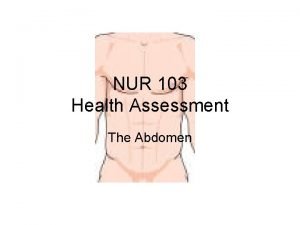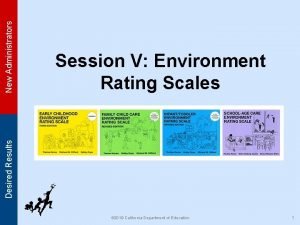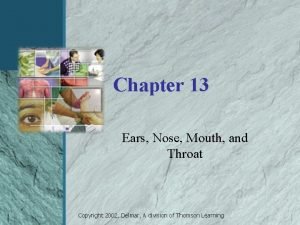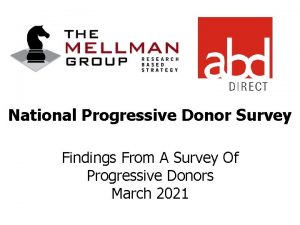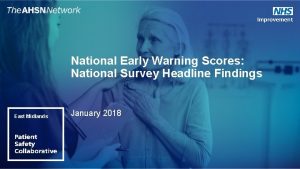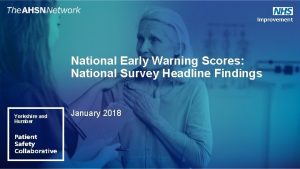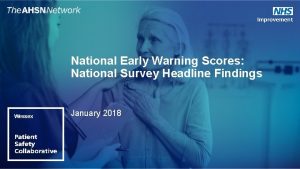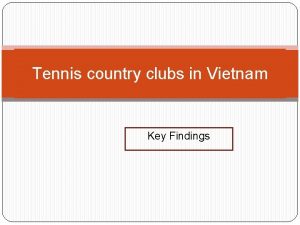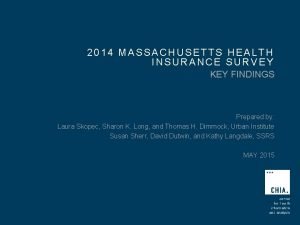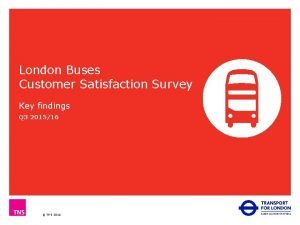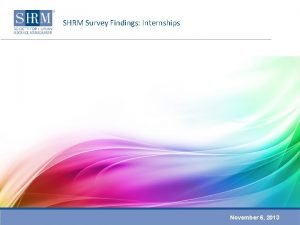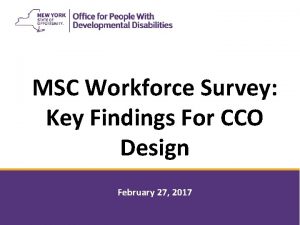Achieve National Survey Key findings from a survey





































- Slides: 37

Achieve National Survey Key findings from a survey of 1, 200 public school parents, conducted May 2016

Methodology On behalf of Achieve, Public Opinion Strategies with Greenberg Quinlan Rosner Research conducted a national survey of 1, 200 public school parents, with at least one child in grades 3– 12 with oversamples of 300 each of Hispanic moms; African‐American moms; and suburban moms with a household income of +$80, 000. The survey was conducted in May 2016 and has a margin of error of +2. 83%. The margin of error for the oversamples is +5. 7%. 2

Funding, over‐testing, and real‐world application are seen as the biggest challenges for K– 12 public schools. Thinking some more about public schools in STATE, which of the following do you think are the greatest issues or challenges facing K– 12 public schools? % Greatest Issues By Key Groups Lack of funding and resources Too much teaching to the test, too many tests Schools do not prepare students for the real world Too many kids in the classroom Too many kids falling behind academically Lack of parental involvement Schools are unsafe/discipline is an issue Low expectations for students Classes are not engaging/interesting for students Schools do not teach a well‐rounded curriculum Bad/poor quality teachers Schools/teachers not accountable for student outcomes Some other issue/challenge None of these is an issue in schools today Parents SB AA Hisp 39% 33% 27% 26% 25% 24% 19% 16% 16% 15% 12% 0% 3% 42% 51% 26% 29% 18% 24% 18% 16% 15% 13% 9% 11% 0% 2% 50% 25% 19% 23% 35% 26% 22% 16% 15% 17% 11% 1% 3% 41% 26% 24% 33% 28% 22% 19% 12% 17% 16% 19% 12% 0% 2% 3

Eighty‐three percent (83%) of parents say today’s graduates are either unprepared or only somewhat prepared for expectations beyond high school. When it comes to academic knowledge and skills, are graduates of our nation’s public high schools: very prepared; somewhat unprepared; or are very unprepared to meet the expectations they’ll face in college, the military, or the workforce? 40% 43% Somewhat Prepared Unprepared 13% Very Prepared Parents 4

…And the feeling extends across all key groups. By Key Group 41% 43% 45% 42% 40% 41% 12% 13% Un‐ Somewhat Very prepared Prepared Somewhat Un‐ Very Prepared prepared Un‐ Very Somewhat prepared Prepared Upper‐Income Suburban Moms African‐American Moms Hispanic Moms 10% 5

A clear majority of parents say a high school diploma does NOT mean a child is ready to take the next step after high school. Does receiving a high school diploma mean a child is ready for college, the military, or the workforce? Parents By Key Group 34% Yes 32% No Total 64% 59% 57% Yes 36% 28% No Yes No Upper‐Income Suburban African‐American Moms Yes 55% No Hispanic Moms 6

Opinions differ on if students should receive a diploma even if they aren’t ready to take that next step after high school. Should students receive a high school diploma even if they aren’t ready for college, the military, or the workforce? Parents 39% 43% By Key Group 44% 58% 40% 38% 46% 23% Yes No Total Yes No Upper‐Income Suburban African‐American Moms Yes No Hispanic Moms 7

Parents want their children to be prepared to earn a four‐year degree. Which of the following is most important that your child be prepared for? Parents 72% Earn a 4‐year degree (Bachelor’s degree) Earn a trade or professional certification valued by employers Earn a 2‐year degree (Associate’s degree) Serve in the military By Key Group 77% 62% 15%12% 1% Total 13%9% 20% 17% 1% 0% Upper‐Income Suburban African‐American Moms 72% 14% 13% 2% Hispanic Moms 8

Parents say all states should have the same standards. Do you believe it is better for all states to have the SAME STANDARDS at each grade level in English and math so students across the country have to meet the same expectations? . . . or… Do you believe it is better for each state to have their OWN STANDARDS at each grade level in English and math so each state can be sure the standards reflect its own priorities? Same standards across all states Each state has its own standards Initial 59% 60% 31% Parents 57% 29% SB Final 35% AA 63% 59% 29% Hisp 64% 31% Parents 54% 28% SB 63% 35% AA 30% Hisp 9

Even when the standards are labeled Common Core, parents still say all states should have the same standards. If those same standards across all the states are the Common Core State Standards, do you think: * All states should have the same standards Each state should have its own standards Parents 54% By Key Group 60% 54% 32% Total 66% 33% 27% Upper‐Income Suburban African‐American Moms * Asked of Sample A 23% Hispanic Moms 10

When their state name is included, support for consistent state standards increases. If those same standards across all states refer to State Name for Standards, do you think: ^ All states should have the same standards Each state should have its own standards Parents 62% By Key Group 62% 26% Total 63% 54% 22% 29% Upper‐Income Suburban African‐American Moms ^ Asked of Sample B 29% Hispanic Moms 11

Upper‐Income Suburban moms have heard significantly more than either African‐American or Hispanic moms about opting out. How much have you seen, read or heard about parents opting their children out of or having their children refuse to take the end‐of‐year state standardized tests? A lot Some Parents Not much Nothing at all By Key Group 39% 35% 32% 25%25% 24%21% 23%20% 19% 15% 12% Total Upper‐Income Suburban African‐American Moms 30% 29% 25% 14% Hispanic Moms 12

Seventy percent (70%)+ of parents report not planning to opt their children out of state standardized tests. Are you planning to, or have you already, opted any of your children out of the end‐of‐year state standardized tests for THIS school year? Yes, already opted them out Yes, planning to opt them out No Parents By Key Group 71% 70% 11% 8% Total 11% 9% 79% 4% 7% Upper‐Income Suburban African‐American Moms 72% 9% 11% Hispanic Moms 13

Thirteen percent (13%) of parents say they opted their children out last year. Did you opt any of your children out of the end‐of‐year state standardized tests LAST year? Parents By Key Group 85% 13% Yes 13% No Total 92% 86% Yes No Yes 5% 85% 11% No Upper‐Income Suburban African‐American Moms Yes No Hispanic Moms 14

More than a quarter of parents know someone who plans to opt their children out this year. Do you know anyone who is planning to, or has already, opted any of their children out of the end‐of‐year state standardized tests for THIS school year? Yes, already opted them out Yes, planning to opt them out No Parents By Key Group 66% 17% 11% Total 78% 60% 24% 11% 8% 6% Upper‐Income Suburban African‐American Moms 70% 13%10% Hispanic Moms 15

Test anxiety, the belief that the tests do not measure ability and adult pressure are driving the opt out movement. Could you tell me some of the reasons people you know (have chosen to opt their child out/are planning to opt their child out) of the end‐of‐year state standardized tests? Please select all that apply. % Reasons Why Opted Out By Key Groups Parents SB AA Hisp 51% 57% 43% 56% 42% 41% 53% 24% 26% 44% 28% 38% 40% 44% 7% 26% 38% 36% 28% 21% 19% 17% 8% 4% 2% 41% 37% 24% 16% 15% 9% 0% 4% 0% 22% 26% 20% 22% 30% 18% 3% 0% 13% 53% Test does a poor job of capturing child’s ability 49% Too much pressure on child by teachers and schools to do well 49% No positive benefit to child taking the test 48% Test anxiety/child nervous about tests Test doesn’t matter/test doesn’t count for anything/not meaningful for my child A voice for parents/way to protest the system/parents take back control Test fatigue/too many tests Child does not do well on tests Child has an IEP or is a Special Education student No negative consequences for opting child out Worried about child’s scores going down/performance will drop Teacher or school administrator recommended child not take it Worried about child taking tests on a computer Test is in English/poor English skills/English is second language 7% 53% 40% 39% 19% 32% 10% 6% 16

Parents, especially Upper‐Income Suburban Moms, say there is too much emphasis on tests. And do you believe there too much emphasis put on standardized tests? Parents By Key Group 75% 62% 59% 28% Yes No Total 33% 19% Yes No 58% Yes No Upper‐Income Suburban African‐American Moms 33% Yes No Hispanic Moms 17

Federal and state governments are said to be MOST responsible for putting too much emphasis on tests. Which of the following do you think is MOST responsible for putting too much emphasis on tests? * Parents Upper‐Income Suburban Moms African‐ American Moms Hispanic Moms Federal Government 35% 40% 25% 29% State 29% 33% 34% 35% School Districts 15% 12% 26% 13% Teachers 7% 3% 4% 5% Schools 6% 3% 5% 10% Parents 4% 3% 3% 3% Principals 2% 3% 1% 4% Guidance Counselors 2% 1% 0% 1% Other 0% 1% 0% 0% All of the above 1% 0% 0% 1% First Choice % Most Responsible By Key Groups * Asked of those who believe there is too much emphasis on standardized tests 18

More parents say students are given the right amount or too few tests than say they are given too many. In general, do you believe that students in public schools are given too many tests, not enough, or about the right amount throughout the school year? Parents By Key Group 2015 53% 10% 43% 33% 57% 44% 36% 27% 15% Too Many Right Too Few Amount Total Right Too Few Amount Too Many Right Too Few Amount Upper‐Income Suburban African‐American Moms 38% 16% 9% Too Many 33% 39% Too Many Right Too Few Amount Hispanic Moms 19

Testing students to make sure they are on track in key courses is seen as very important. How important is it to test students from grades 3 through 12 to know if they are on track in reading, writing, and math? * Parents 90% By Key Group 86% 61% Very Not Important 44% Very Total 93% 69% Very 68% Very Not Important 13% 9% Important 94% Important Not Important 6% 5% Important Upper‐Income Suburban African‐American Moms * Asked of Sample A Important Hispanic Moms 20

Testing students to ensure they will be ready for college and the workplace upon graduation is also seen as very important. How important is it to test students from grades 3 through 12 to know if they are on track in reading, writing, and math so they can graduate from high school ready for college and the workplace? ^ Parents 89% By Key Group 88% 63% Very 92% 91% 74% Very 51% Very Not Important 11% 10% Important Total Important Not Important 9% 7% Important Upper‐Income Suburban African‐American Moms ^ Asked of Sample B Important Hispanic Moms 21

Parents say it is best for all states to have the same tests. Do you believe that it is better for all states to have the SAME standardized tests for all students at each grade level in English and math, which will allow for test scores to be compared across states? . . . or… Do you believe it is better for each state to have their OWN standardized tests at each grade level in English and math so each state can be sure the tests reflect its own priorities? Parents By Key Group 2015 58% 16% 60% 57% 33% Same Tests Different Tests Total 35% 29% Same Tests 62% 57% Different Tests Same Tests Different Tests Upper‐Income Suburban African‐American Moms 31% Same Tests Different Tests Hispanic Moms 22

Parents place the most value on tests used for college admissions or in classroom. What ONE type of testing do you value most? Parents Upper‐ Income Suburban Moms African‐American Moms Hispanic Moms ACT, SAT, or other high school tests that are used for admission to college 30% 25% 28% 36% Classroom tests 28% 33% 25% 23% State standardized tests 10% 9% 16% 13% Finals 9% 8% 9% 11% Employer tests (e. g. , IT certification, CPA exam, trades licenses, etc. ) 9% 10% 5% 6% District benchmark tests 6% 7% 6% 6% The military entrance exam, known as the ASVAB 1% 0% 1% 1% % Most Valued By Key Groups 23

Conferences and online resources are the most useful tools to track academic progress. What is most useful to you as a parent for understanding how your child is doing academically in school? Parent‐Teacher Conferences Online portals, reports, and resources Report Cards Classroom tests and quizzes State standardized tests Parents By Key Group 34% 33% 32% 28% 27%23% 24%21% 18% 14% 13% 12%8% 10% 8% 6% 6% Total Upper‐Income Suburban African‐American Moms Hispanic Moms 24

A plurality of parents say getting the results of standardized tests takes too much time. Thinking some more about state standardized tests, do you think that you getting the results back takes too much time, too little time, or about the right amount of time? Too much time, Too little time, Right amount of time, I do not get the results Parents 40% By Key Group 49% 35% 10% Total 8% 34% 4% 6% 39% 35% 7% 9% Upper‐Income Suburban African‐American Moms 44% 34% 9% 6% Hispanic Moms 25

Once they do get reports of standardized test results, parents consider them useful. Are the reports you receive on your child’s results from state standardized tests useful to you? Parents By Key Group 81% 78% 74% 61% 30% Very 26% Useful Not Useful Total 39% 20% Very Useful Not Useful 33% Very Useful 41% Very 22% Not Useful Upper‐Income Suburban African‐American Moms 19% Useful Not Useful Hispanic Moms 26

Section 1 For the following statements, you have 100 points to distribute however you would like. The more points you give a statement, the more concerning that statement is to you as a parent. So, for example, if you thought only ONE of the statements was concerning, you would give that statement 100 points. If you thought just two statements were concerning, but they were equally concerning, you would give each statement 50 points. For statements that you do not think are concerning at all, please just write 0. Again, you can distribute the points in any way that you would like. 27

Section 1: Parents – Concerning Statement Ranking Mean Q 25. In STATE, XX% of the workforce has a 4‐year college degree, while 15. 1 XX% of the jobs require a 4‐year college degree. Q 32. In STATE, XX% of 8 th graders met proficient or advanced benchmarks in math, according to the National Assessment of 13. 7 Educational Progress (a national test given to a sample of students across in all states) in 2015. Q 24. In STATE, XX% of the workforce has only a high school diploma, while XX% of the jobs are available to workers who have only a high 13. 6 school diploma. Q 30. In STATE, XX% of college students are required to pay for and take remedial (non‐credit) courses, essentially taking high school level work before they can start college level study. ^ * Only Asked of AL, CO, IL, KY, LA, MI, MS, MT, NC, ND, TN, UT, WY; ^ Only Asked of AL, AR, CO, CT, DE, FL, ID, IN, ME, MD, MA, MI, MN, MO, MT, NV, NM, NY, OH, OK, OR, SD, VA, WV 13. 4 28

Section 1: Upper‐Income Suburban Moms – Concerning Statement Ranking Q 27. In STATE, XX% of high school graduates in 2014 met ACT’s Reading College Readiness Benchmark and XX of high school graduates in 2014 met the ACT Math College Readiness Benchmark and XX% of high school graduates in 2014 met the ACT Science College Readiness Benchmark. * Mean 15. 0 Q 25. In STATE, XX% of the workforce has a 4‐year college degree, while 14. 7 XX% of the jobs require a 4‐year college degree. Q 32. In STATE, XX% of 8 th graders met proficient or advanced benchmarks in math, according to the National Assessment of 14. 5 Educational Progress (a national test given to a sample of students across in all states) in 2015. Q 31. In STATE, XX% of 4 th graders met proficient or advanced benchmarks in reading, according to the National Assessment of 14. 3 Educational Progress (a national test given to a sample of students across in all states) in 2015. * Only Asked of AL, CO, IL, KY, LA, MI, MS, MT, NC, ND, TN, UT, WY; ^ Only Asked of AL, AR, CO, CT, DE, FL, ID, IN, ME, MD, MA, MI, MN, MO, MT, NV, NM, NY, OH, OK, OR, SD, VA, WV 29

Section 1: African‐American Moms – Concerning Statement Ranking Mean Q 28. In STATE, XX% of high school students graduate in 4 years, but only 17. 0 XX% of high school students from low‐income families graduate in 4 years. Q 25. In STATE, XX% of the workforce has a 4‐year college degree, while 15. 6 XX% of the jobs require a 4‐year college degree. Q 30. In STATE, XX% of college students are required to pay for and take remedial (non‐credit) courses, essentially taking high school level work before they can start college level study. ^ 14. 0 Q 24. In STATE, XX% of the workforce has only a high school diploma, while XX% of the jobs are available to workers who have only a high 13. 5 school diploma. * Only Asked of AL, CO, IL, KY, LA, MI, MS, MT, NC, ND, TN, UT, WY; ^ Only Asked of AL, AR, CO, CT, DE, FL, ID, IN, ME, MD, MA, MI, MN, MO, MT, NV, NM, NY, OH, OK, OR, SD, VA, WV 30

Section 1: Hispanic Moms – Concerning Statement Ranking Q 27. In STATE, XX% of high school graduates in 2014 met ACT’s Reading College Readiness Benchmark and XX of high school graduates in 2014 met the ACT Math College Readiness Benchmark and XX% of high school graduates in 2014 met the ACT Science College Readiness Benchmark. * Mean 15. 9 Q 28. In STATE, XX% of high school students graduate in 4 years, but only 15. 2 XX% of high school students from low‐income families graduate in 4 years. Q 25. In STATE, XX% of the workforce has a 4‐year college degree, while 15. 0 XX% of the jobs require a 4‐year college degree. Q 26. In STATE, XX% of the jobs are STEM (Science, Technology, Engineering, and Math) jobs, and XX% of these STEM jobs require at least a 4‐year college degree. * Only Asked of AL, CO, IL, KY, LA, MI, MS, MT, NC, ND, TN, UT, WY; ^ Only Asked of AL, AR, CO, CT, DE, FL, ID, IN, ME, MD, MA, MI, MN, MO, MT, NV, NM, NY, OH, OK, OR, SD, VA, WV 13. 9 31

Section 2 The federal government recently passed new legislation replacing the federal education law known as No Child Left Behind (or NCLB). The new law, known as the Every Student Succeeds Act, places more responsibility on state and local governments to monitor student progress in order to receive federal funding, but also removes many of the mandates or requirements of NCLB. One provision of the new law is Annual State and Local Report Cards: these report cards must include information for the performance of school districts, as well as for each school in a district. The following categories of information are required to be reported by states and school districts. For the following 11 categories of information, you have 100 points to distribute however you would like. The more points you give a category of information, the more important that information is to you as a parent. So, for example, if you thought only ONE of the categories of information was important, you would give that statement 100 points. If you thought just two categories of information were important, but they were equally important, you would give each statement 50 points. For categories of information that you do not think are important at all, please just write 0. 32

Section 2: Parents – Importance Category Ranking Q 41. Professional qualification of teachers across districts and schools (with breakdowns between high‐poverty and low‐poverty schools), including the number and percentage of: inexperienced teachers and principals; teachers with emergency credentials; and teachers teaching out‐of‐field subjects Mean 13. 0 Q 42. Annual spending on each student by fund source (federal, state, local) across schools in districts 9. 9 Q 39. Graduation Rates, both overall, and by sub‐groups 8. 1 Q 36. Schools identified for Targeted Support and Improvement 7. 7 33

Section 2: Upper‐Income Suburban Moms – Importance Category Ranking Mean Q 42. Annual spending on each student by fund source (federal, state, local) across schools in districts 12. 9 Q 41. Professional qualification of teachers across districts and schools (with breakdowns between high‐poverty and low‐poverty schools), including the number and percentage of: inexperienced teachers and principals; teachers with emergency credentials; and teachers teaching out‐of‐field subjects 12. 8 Q 45. College‐going rates for high school graduates, both overall, and by sub‐group 8. 6 Q 39. Graduation Rates, both overall, and by sub‐groups 8. 3 34

Section 2: African‐American Moms – Importance Category Ranking Mean Q 41. Professional qualification of teachers across districts and schools (with breakdowns between high‐poverty and low‐poverty schools), including the number and percentage of: inexperienced teachers and principals; teachers with emergency credentials; and teachers teaching out‐of‐field subjects 12. 2 Q 39. Graduation Rates, both overall, and by sub‐groups 11. 0 Q 45. College‐going rates for high school graduates, both overall, and by sub‐group 8. 5 Q 42. Annual spending on each student by fund source (federal, state, local) across schools in districts 8. 0 35

Section 2: Hispanic Moms – Importance Category Ranking Mean Q 41. Professional qualification of teachers across districts and schools (with breakdowns between high‐poverty and low‐poverty schools), including the number and percentage of: inexperienced teachers and principals; teachers with emergency credentials; and teachers teaching out‐of‐field subjects 14. 8 Q 42. Annual spending on each student by fund source (federal, state, local) across schools in districts 8. 9 Q 39. Graduation Rates, both overall, and by sub‐groups 8. 4 Q 44. Statewide results of the National Assessment of Educational Progress (NAEP) compared with the national average 7. 9 36

Key Findings In General • Parents are concerned about the readiness of graduates for life after high school, especially the mismatch between skills and workforce requirements • They express this anxiety by questioning the value of a high school diploma • Nevertheless, by an overwhelming margin, they want their children prepared to enter a 4‐year postsecondary institution • As called for in ESSA reporting requirements, parents are extremely interested in knowing the qualifications of their children’s teachers Standards & Testing • A majority of parents think that all states should have the same academic standards whether referred to as “Common Core” or by their state’s name • Parents generally feel there is too much emphasis on tests • As a result, there is higher awareness and acceptance of “opt out” • However, parents also believe it is important to measure student progress and when presented with relevant and timely results support testing 37
 Example of findings in research
Example of findings in research Remembering world war 1 achieve 3000
Remembering world war 1 achieve 3000 Key partner adalah
Key partner adalah Key partners key activities key resources
Key partners key activities key resources 叫叫 abcd
叫叫 abcd Findings of qualitative research
Findings of qualitative research Decreased tactile fremitus
Decreased tactile fremitus Communication of research finding
Communication of research finding Characteristics of research methodology
Characteristics of research methodology Why is tactile fremitus decreased in pleural effusion
Why is tactile fremitus decreased in pleural effusion Rickets xray
Rickets xray Results and discussion example
Results and discussion example Pneumothorax auscultation findings
Pneumothorax auscultation findings Qualitative vs quantitative
Qualitative vs quantitative Recommendation and conclusion example
Recommendation and conclusion example Four quadrants of the abdomen
Four quadrants of the abdomen Acute interstitial nephritis urine findings
Acute interstitial nephritis urine findings Ecers summary of findings
Ecers summary of findings Atrial fibrilation ekg
Atrial fibrilation ekg Megaloblastic anemia causes
Megaloblastic anemia causes Megaloblastic anemia mcv
Megaloblastic anemia mcv Vwf deficiency labs
Vwf deficiency labs Presenting insights and findings using written reports
Presenting insights and findings using written reports Nose assessment normal findings
Nose assessment normal findings Jin et al attachment study
Jin et al attachment study Pansitopenia adalah
Pansitopenia adalah Pathophysiology of aplastic anemia
Pathophysiology of aplastic anemia Megaloblastic anemia causes
Megaloblastic anemia causes Example of applied research
Example of applied research What do the findings of roper's experiment suggest?
What do the findings of roper's experiment suggest? Pv miub
Pv miub Rickets x ray wrist
Rickets x ray wrist Announcing your findings
Announcing your findings Crescent sign x ray intussusception
Crescent sign x ray intussusception Desired results parent survey
Desired results parent survey Chapter four data presentation and analysis
Chapter four data presentation and analysis The jesus seminar findings
The jesus seminar findings Nutrition focused physical exam
Nutrition focused physical exam















